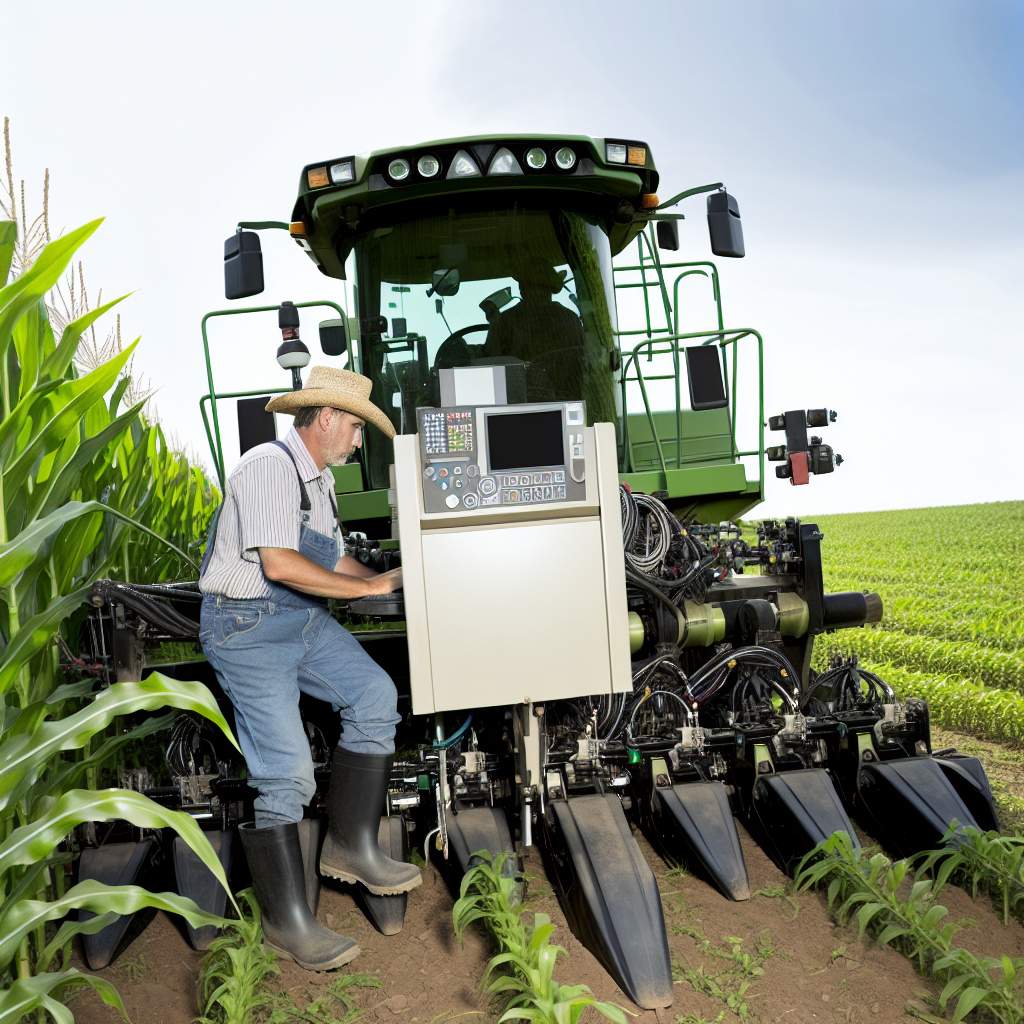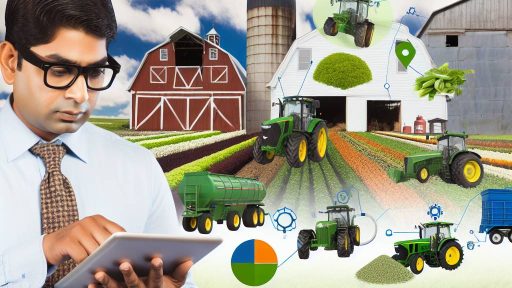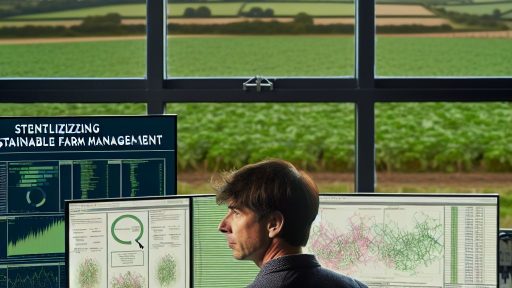Introduction to Automated Machinery in Farming
Automated machinery is revolutionizing the farming industry.
This technology significantly enhances efficiency and productivity.
Farmers are increasingly adopting automation to meet rising food demands.
Currently, a variety of automated machines exist in the agricultural sector.
These include autonomous tractors, drones, and robotic harvesters.
Importance of Automation in Agriculture
Automation streamlines operations and reduces manual labor costs.
With automated systems, farmers can optimize their resource usage.
Moreover, automation aids in precision farming practices.
This ensures that crops receive exactly what they need for growth.
Consequently, this approach minimizes waste and increases yields.
Current Status of Automated Machinery
Today, automated machinery is at a pivotal stage of development.
Many farms have integrated smart technologies into their workflows.
For instance, data analytics plays a crucial role in farm decision-making.
Furthermore, companies like AgriTech Innovations lead the way with innovative solutions.
Their systems help monitor crop health and soil conditions.
Transform Your Agribusiness
Unlock your farm's potential with expert advice tailored to your needs. Get actionable steps that drive real results.
Get StartedChallenges in Implementing Automated Solutions
Despite its advantages, challenges remain in adopting automated machinery.
High initial costs can deter some farmers from investing in technology.
Additionally, there is often a steep learning curve for new systems.
Also, concerns about job displacement impact worker sentiments.
However, training programs can mitigate these concerns effectively.
Future Prospects of Automation in Farming
The future of farming lies in advanced automation capabilities.
Emerging technologies promise even greater efficiencies and sustainability.
For example, developments in AI can lead to smarter operational decisions.
In conjunction, advancements in robotics will enhance planting and harvesting.
Ultimately, the evolution of automated machinery can reshape global agriculture.
Key Technologies Driving Automation in Agriculture
Precision Agriculture
Precision agriculture utilizes GPS technology for field mapping.
This innovation enhances crop yields by enabling targeted interventions.
Farmers can now optimize their inputs based on real-time data.
Consequently, they can reduce waste and increase efficiency.
Robotics and Automated Machinery
Robotics revolutionizes tasks such as planting and harvesting.
Automated tractors perform work with minimal human supervision.
These machines can operate 24/7, improving productivity significantly.
As technology advances, more complex tasks will be automated.
Artificial Intelligence and Machine Learning
AI and machine learning analyze vast amounts of agricultural data.
This analysis drives decision-making in crop management.
Farmers receive insights on crop health, weather patterns, and soil conditions.
In turn, this leads to more informed and timely actions.
Drones in Agriculture
Drones provide aerial imagery for detailed crop monitoring.
They can assess crop health and identify pest infestations quickly.
Showcase Your Farming Business
Publish your professional farming services profile on our blog for a one-time fee of $200 and reach a dedicated audience of farmers and agribusiness owners.
Publish Your ProfileAdditionally, drones are effective for irrigation management.
Farmers use them to ensure efficient water usage across fields.
Blockchain Technology
Blockchain enhances transparency in the agricultural supply chain.
This technology secures transactions and traceability of products.
Consumers can verify the source and quality of their food.
This builds trust and accountability between farmers and consumers.
Vertical Farming and Hydroponics
Vertical farming optimizes space by growing crops in stacked layers.
This method uses controlled environments to maximize yields.
Hydroponics offers soil-less farming options, reducing resource consumption.
These techniques are increasingly popular in urban agriculture.
Impact of AI and Machine Learning on Crop Management
Enhancing Precision Agriculture
AI and machine learning dramatically enhance precision agriculture techniques.
Farmers now leverage data-driven insights to optimize their crop yields.
This technology analyzes soil health, moisture levels, and weather patterns effectively.
Consequently, farmers make informed decisions about planting and harvesting times.
These strategies reduce waste while improving overall efficiency.
Predictive Analytics for Better Decision-Making
Predictive analytics give farmers an edge in anticipating crop performance.
These models forecast potential issues related to pests and diseases.
By early detection, farmers can implement targeted interventions.
This minimizes crop losses and boosts productivity significantly.
Additionally, timely data allows for better resource allocation throughout the growing season.
Automating Routine Tasks
Automation of routine farming tasks increases operational efficiency.
For instance, robotic systems now handle tasks like planting and harvesting with precision.
This reduces the labor demand and lowers operational costs.
Moreover, automation allows farmers to focus on strategic planning rather than mundane tasks.
Ultimately, it leads to higher productivity across various farming operations.
Improving Crop Monitoring
AI-driven crop monitoring systems enhance the assessment of crop health.
Drones equipped with sensors can collect real-time data over large areas.
This information helps farmers identify issues faster than traditional methods.
As a result, proactive measures can be taken to address emerging threats.
Such insights foster a more resilient agricultural ecosystem.
Data-Driven Sustainability Practices
AI and machine learning contribute to sustainable farming practices.
Farmers use these technologies to optimize inputs such as water and fertilizers.
This targeted approach protects natural resources and enhances yield quality.
Moreover, it aligns agriculture with environmental stewardship principles.
Consequently, it supports long-term sustainability goals within the industry.
Uncover the Details: Greenhouse Technologies Advancing Sustainable Agricultural Methods
Benefits of Automated Machinery
Efficiency in Farming Operations
Automated machinery significantly improves efficiency in farming operations.
These machines can operate continuously, reducing downtime on tasks.
Moreover, they perform tasks at a consistent speed and quality.
This leads to higher yields and better crop quality overall.
Showcase Your Farming Business
Publish your professional farming services profile on our blog for a one-time fee of $200 and reach a dedicated audience of farmers and agribusiness owners.
Publish Your ProfileFurthermore, automation decreases the need for manual labor.
This allows farmers to allocate resources to strategic planning.
Cost Reduction
Investing in automated machinery leads to substantial cost reduction.
Initially, the investment may seem high, but savings follow quickly.
Farmers report lower operational costs over time.
Automated systems minimize waste through precise resource management.
This precision leads to efficient use of seeds, fertilizers, and water.
Also, reduced labor costs significantly impact the bottom line.
Sustainability Practices
Automated machinery promotes sustainable farming practices effectively.
These machines can integrate sensor technology to monitor conditions.
Real-time data helps farmers make informed decisions.
Additionally, they can optimize pesticide and fertilizer application.
This leads to less environmental impact and healthier soil.
Furthermore, automated machinery supports crop rotation and diversity efforts.
Such practices encourage long-term agricultural sustainability.
Explore Further: Genetically Modified Crops: Myths Vs. Facts For Farmers
Challenges and Limitations of Adopting Automated Farming Equipment
High Initial Costs
Investing in automated farming equipment requires significant capital.
Many small to medium-sized farms struggle to cover these upfront expenses.
Moreover, financing options may not be readily available for all farmers.
Such financial barriers can deter potential adopters from transitioning to automation.
Technological Complexity
Operating automated machinery necessitates a certain level of technical expertise.
Farmers may need to undergo training to use these advanced systems effectively.
Additionally, regular maintenance and troubleshooting can pose challenges.
A lack of tech-savvy laborers can hinder the adoption of new equipment.
Dependence on Technology
Reliance on automated equipment increases vulnerability to technical failures.
System malfunctions can disrupt operations and lead to significant losses.
Furthermore, farmers must consider backup plans for equipment failure.
This dependence also raises concerns about data security and privacy.
Labor Concerns
Automated machinery can reduce the need for manual labor on farms.
This change can lead to job displacement in rural communities.
Many people express concerns about the future of agricultural jobs.
Farmers must balance the benefits of automation with local employment needs.
Regulatory and Compliance Issues
Adopting automated equipment may require navigating complex regulations.
Farmers must ensure compliance with federal and state agricultural laws.
In some cases, regulations may lag behind technological advancements.
This discrepancy can create confusion and hinder equipment integration.
Market Readiness
The market for automated farming solutions is still evolving.
Not all regions have access to necessary support services and technologies.
Farmers may encounter challenges in sourcing compatible equipment.
This limitation can affect their ability to fully utilize automation advantages.
Showcase Your Farming Business
Publish your professional farming services profile on our blog for a one-time fee of $200 and reach a dedicated audience of farmers and agribusiness owners.
Publish Your ProfileGain More Insights: Implementing Smart Sensors for Crop Monitoring

Future Trends: Robotics, Drones, and Precision Agriculture
Advancements in Robotics
Robotic technology is revolutionizing modern farming practices.
These machines help farmers increase efficiency and reduce labor costs.
For instance, robotic harvesters can work continuously, day or night.
They perform tasks such as picking fruits and vegetables with precision.
Additionally, robots can monitor crops and detect diseases early.
This capability allows for timely interventions and minimizes crop loss.
Ultimately, robotics enhances productivity in the agricultural sector.
The Rise of Drone Technology
Drones are becoming essential tools in agriculture.
Farmers use them for aerial surveying and precision mapping.
These devices provide real-time data on crop health and soil conditions.
Moreover, drones facilitate efficient irrigation management.
They can identify areas that require more or less water.
Furthermore, drones support targeted pesticide and fertilizer application.
This approach reduces chemical usage and environmental impact.
Precision Agriculture Practices
Precision agriculture is changing how farmers approach their operations.
This method utilizes data analytics to optimize farm inputs.
Technologies such as GPS and sensors play a crucial role.
Farmers can apply fertilizers and pesticides more effectively.
As a result, they minimize waste and enhance crop yields.
Also, precision tools help farmers make informed decisions based on real data.
This shift leads to sustainable farming practices and environmental benefits.
Integration of Sustainable Practices
Automated machinery aligns well with sustainable agriculture goals.
Farmers can reduce resource usage, like water and fertilizers.
Robots and drones work together to promote eco-friendly solutions.
Sustainability is essential for meeting future food demands.
Investments in technology lead to long-term viability in farming.
Clearly, innovation plays a key role in shaping the future of agriculture.
See Related Content: A Comprehensive Guide to Controlled Environment Agriculture
Case Studies: Successful Implementation of Automated Farming Solutions
Overview of Automated Farming Solutions
Automated farming solutions enhance efficiency in agriculture.
These technologies streamline various farming processes.
For instance, automated machinery can handle planting, watering, and harvesting.
Many farmers are adopting these solutions to improve productivity.
Example: GreenField Innovations
GreenField Innovations has revolutionized crop management.
They implemented precision farming techniques to maximize yield.
This company uses drones for monitoring crop health.
Additionally, they utilize automated tractors for planting and harvesting.
The results significantly increased their production rates.
Case Study: Riverbend Farms
Riverbend Farms adopted an automated irrigation system.
This system uses sensors to monitor soil moisture.
Showcase Your Farming Business
Publish your professional farming services profile on our blog for a one-time fee of $200 and reach a dedicated audience of farmers and agribusiness owners.
Publish Your ProfileAs a result, the farm reduced water usage by 30%.
Moreover, crop quality improved due to optimized watering schedules.
The farm achieved notable cost savings and environmental benefits.
Benefits of Automation in Agriculture
Automated solutions increase efficiency across agricultural practices.
They also minimize human error in operations.
Furthermore, these technologies allow farmers to focus on strategic tasks.
By adopting automation, farmers can respond to market demands swiftly.
Such advancements pave the way for sustainable farming practices.
Challenges Faced During Implementation
Despite the benefits, implementing automated systems can pose challenges.
Initial costs for machinery and technology can be high.
Additionally, training staff to use new technology may be necessary.
Some farmers also face resistance to change among their workforce.
Overcoming these challenges is crucial for successful automation.
Future Prospects for Automated Farming
The future of farming relies heavily on automation and technology.
Emerging technologies are likely to drive further efficiency.
Farmers can expect enhanced data analytics for better decision-making.
Ultimately, automated solutions will play a vital role in global food security.
Investments in these technologies are expected to grow in the coming years.
Policy and Regulatory Frameworks Governing the Use of Automated Machinery in Agriculture
Current Regulatory Landscape
The agricultural sector faces numerous regulations regarding automated machinery usage.
These regulations primarily focus on safety, environmental impact, and worker protection.
Government bodies, like the U.S. Department of Agriculture, oversee compliance.
Furthermore, international regulations may influence local laws as well.
Emerging Policies Regarding Automation
Recently, policies have begun addressing innovations in farming technology.
These policies aim to increase efficiency and sustainability across the sector.
Moreover, they seek to balance technological advancement with regulatory oversight.
Industry Standards and Compliance
Industry standards play a crucial role in the adoption of automated machinery.
Farmers must ensure their equipment meets safety and quality benchmarks.
Failure to comply could result in fines or legal action against agricultural enterprises.
Future Trends in Regulation
As technology evolves, regulations will likely also adapt.
Future regulations may focus on data privacy and cybersecurity in automation systems.
Additionally, regulatory bodies might introduce incentives for adopting eco-friendly technologies.
Collaboration Between Stakeholders
Collaboration among farmers, manufacturers, and regulators is essential.
This cooperation ensures effective implementation of automated farming solutions.
Industry groups, such as the Farm Equipment Manufacturers Association, advocate for sensible policies.
Engagement with these stakeholders can lead to more balanced regulations.
Global Perspectives on Regulation
Countries across the globe are developing their agricultural machinery policies.
Each region faces unique challenges related to its agricultural landscape.
Consequently, understanding international regulations can benefit local farmers.
Moreover, sharing best practices between countries can enhance global agricultural productivity.
Additional Resources
Precision Agriculture Is Shaping the Future of Farming | Agrilinks
Showcase Your Farming Business
Publish your professional farming services profile on our blog for a one-time fee of $200 and reach a dedicated audience of farmers and agribusiness owners.
Publish Your ProfileAI in Agriculture — The Future of Farming




